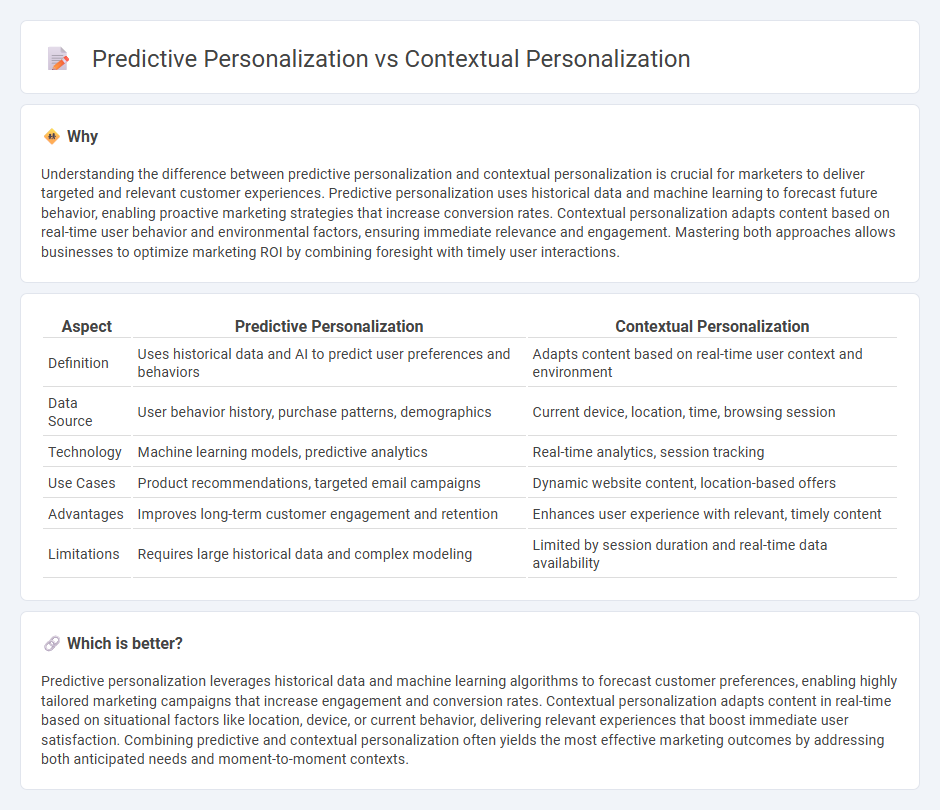
Predictive personalization leverages data analytics and machine learning to anticipate customer preferences and deliver tailored marketing messages before the user takes action. Contextual personalization focuses on real-time data such as location, device, and current behavior to adapt content dynamically during user interaction. Explore how combining predictive and contextual personalization can transform your marketing strategy.
Why it is important
Understanding the difference between predictive personalization and contextual personalization is crucial for marketers to deliver targeted and relevant customer experiences. Predictive personalization uses historical data and machine learning to forecast future behavior, enabling proactive marketing strategies that increase conversion rates. Contextual personalization adapts content based on real-time user behavior and environmental factors, ensuring immediate relevance and engagement. Mastering both approaches allows businesses to optimize marketing ROI by combining foresight with timely user interactions.
Comparison Table
| Aspect | Predictive Personalization | Contextual Personalization |
|---|---|---|
| Definition | Uses historical data and AI to predict user preferences and behaviors | Adapts content based on real-time user context and environment |
| Data Source | User behavior history, purchase patterns, demographics | Current device, location, time, browsing session |
| Technology | Machine learning models, predictive analytics | Real-time analytics, session tracking |
| Use Cases | Product recommendations, targeted email campaigns | Dynamic website content, location-based offers |
| Advantages | Improves long-term customer engagement and retention | Enhances user experience with relevant, timely content |
| Limitations | Requires large historical data and complex modeling | Limited by session duration and real-time data availability |
Which is better?
Predictive personalization leverages historical data and machine learning algorithms to forecast customer preferences, enabling highly tailored marketing campaigns that increase engagement and conversion rates. Contextual personalization adapts content in real-time based on situational factors like location, device, or current behavior, delivering relevant experiences that boost immediate user satisfaction. Combining predictive and contextual personalization often yields the most effective marketing outcomes by addressing both anticipated needs and moment-to-moment contexts.
Connection
Predictive personalization leverages data analytics and machine learning to forecast customer preferences, while contextual personalization adapts marketing content based on real-time user context such as location, device, and behavior. Both approaches enhance customer experience by delivering relevant, timely, and personalized messages that increase engagement and conversion rates. Integrating predictive insights with contextual factors enables marketers to optimize campaigns through dynamically tailored offers and interactions.
Key Terms
Real-time data
Contextual personalization leverages real-time data by analyzing a user's current environment, behavior, and preferences to deliver highly relevant content or offers instantly. Predictive personalization uses historical data and machine learning algorithms to forecast a user's future needs and preferences, enabling proactive recommendations. Explore how these approaches can enhance user experience and drive engagement through dynamic data utilization.
Behavioral analytics
Behavioral analytics plays a crucial role in both contextual and predictive personalization by tracking user interactions to tailor experiences. Contextual personalization leverages real-time data such as location, device, and current behavior to deliver relevant content instantly. Explore how advanced behavioral analytics can enhance the effectiveness of both personalization strategies.
Machine learning
Contextual personalization leverages real-time data such as location, device type, and current behavior to tailor user experiences dynamically, whereas predictive personalization uses machine learning algorithms to analyze historical data and forecast future user preferences and actions. Machine learning models like collaborative filtering, regression analysis, and neural networks enable predictive personalization by identifying patterns and anticipating user needs before interaction occurs. Explore how advanced machine learning techniques can transform your personalization strategy for enhanced customer engagement.
Source and External Links
What is Contextual Personalization? Benefits & Challenges - Contextual personalization customizes digital experiences by delivering the right message, product, or experience to each user based on their real-time context such as location, device, time, and behavior rather than static data like demographics or past purchases.
Personalization and Contextualization - Real-World Context - Contextual personalization leverages real-world signals like user activity detected through AI on-device to tailor app interactions instantly, improving engagement and user satisfaction while protecting privacy.
Contextual marketing vs. personalization - Contextual personalization focuses on adapting marketing messages to the consumer's current environment and situation to deliver highly relevant and timely experiences, differentiating it from traditional personalization based on past preferences.
 dowidth.com
dowidth.com